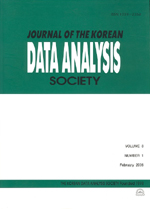문제기반 과학학습의 뇌파분석을 통한 뇌파조절 설계모형연구
Problem-based EEG Neurofeedback Training Design Model for the Science Learning
- 한국자료분석학회
- Journal of The Korean Data Analysis Society (JKDAS)
- Vol.9 No.4
-
2007.081885 - 1899 (15 pages)
- 24

본 연구는 네 가지 과학수업방식(강의식 전개 및 정리, 실험식 전개 및 정리)에 따른 성별, 과학탐구능력, 과학학습태도 등 일반적인 변수군과 뇌기능분화와 통합뇌 여부 등 뇌관련 변수군 간의 관련성을 분석한 것이다. 이를 위해서 SMR파의 활성도 값을 이용하여 뇌기능분화를 4개의 집단으로 분류하였고, 통합뇌 여부를 3개의 집단으로 분류하였다. 그리고 일반적인 변수군과 뇌관련 변수군 간의 관련성을 파악하기 위해 교대최소제곱법을 이용하여 최적화 알고리즘을 반복하여 각 변수의 범주를 나타내는 지표행렬을 제시하는 비선형 정준상관분석을 실시하였다. 분석결과 문제중심해결 과정에서 나타나는 뇌파를 활용한 뉴로피드백 훈련을 통해 적절한 뇌파를 구성하여 뇌의 기능적 특징에 따른 과학학습에 대한 객관적인 문제기반방식의 학습모형을 설계하였다. 뇌파는 뇌의 활동상태에 따라 다르게 나타나며, 자신의 뇌에 다양한 훈련으로 피드백을 받게 되면 특정파에 대한 조절능력을 갖게 된다.
The purpose of this study was to analyze the differences between the general variables such as sex, science exploration ability, science learning attitude and brain hemispheric lateralization variables to investigate its relationship with science learning types (lecture deployment and summary, experiment deployment and summary). The result of this study constructs the effective EEG self-control through the neurofeedback by designing the problem based learning model by the functional characteristics of the brain function. EEG shows the different brain activity by the brain status. It was discovered that the brainwave control is possible by the neurofeedback.. Alternation least squares is used to investigate the relationship of the brain related variables using the repeated the optimized algorithm to show the goal-indicator matrix category of each variables. And nonlinear canonical correlation analysis is applied to obtain the value of the optimized criteria to maximize the relationships between variables.
1. 서론
2. 뇌파조절 과학학습 설계 모형
3. 연구방법
4. 연구결과
5. 결론
참고문헌
(0)
(0)